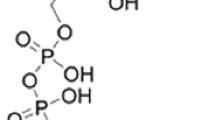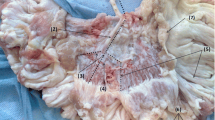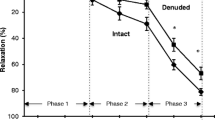Abstract
Adenosine and adenosine triphosphate (ATP) induced vasodilatation was studied in isolated rat perfused mesenteric artery at constant flow. Decrease in perfusion pressure was measured after induction of tone by continuous infusion with phenylephrine (5–7 μM). Adenosine and ATP caused dose-dependent vasodilatation. Following infusion with selective A2 adenosine receptor antagonist, 3,7-dimethyl-l-propargylxanthine (DMPX) (10 μM), or non-selective adenosine receptor antagonist, theophylline (30 μM), vasodilatation produced by adenosine were significantly reduced at lower doses. Responses to adenosine were not affected by pretreatment of tissues with either the P2-purinoceptor desensitizing agent, α, β methylene ATP (30 μM), or the P2-purinoceptor antagonist, suramin (10 μM). In contrast, both α, β methylene ATP and suramin significantly attenuate relaxation produced by ATP. Further, it was found that relaxation elicited by either adenosine or ATP was not significantly affected by the presence of glibenclamide (30 μM). Vasodilatation induced by adenosine and ATP was greatly reduced in denuded arteries but more so for ATP than adenosine. It is concluded that adenosine-mediated vasodilatation may hardly be due to the stimulation of A2 adenosine receptors and is strongly dependent on the presence of functional endothelium whereas ATP-mediated vasodilator responses were mediated via the activation of P2y-purinoceptors and appeared to be entirely dependent upon the presence of functional endothelium. Further, vasodilator responses to neither adenosine nor ATP were sensitive to inhibition by the potassium channel blocker glibenclamide, in isolated mesenteric perfused bed. This would imply that ATP-sensitive potassium channels were not involved in adenosine and ATP mediated vasodilatation.
Similar content being viewed by others
References
Belloni FL, Hintze TH (1991) Glibenclamide attenuates adenosineinduced bradycardia and coronary vasodilatation. Am J Physiol 261:H720-H727
Brizzolara AL, Crowe R, Burnstock G (1993) Evidence for the involvement of both ATP and nitric oxide in non-adrenergic, non-cholinergic inhibitory neurotransmission in the rabbit portal vein. Br J Pharmacol 109:606–608
Burnstock G (1978) A basis for distinguishing two types of purinergic receptor. In: Straub RW, Bolis L (eds) Cell membrane receptors for drugs and hormones: a multidisciplinary approach. Raven Press, New York, pp 107–118
Burnstock G, Warland JJI (1987) P2-purinoceptors of two subtypes in the rabbit mesenteric artery: reactive blue 2 selectivitely inhibits responses mediated via the P2y- but not P2x-purinoceptor. Br J Pharmacol 90:383–391
Choi O, Shamim MT, Padgett WL, Daly JW (1988) Caffeine and theophylline analogues: correlation of behavioral effects with activity as adenosine receptor antagonists and as phosphodiesterase inhibitors. Life Sci 43:387–398
Collis MG Hourani SM (1993) Adenosine receptor subtypes. Trends Pharmacol Sci 14:360–366
Daly JW, Padgett W, Shamim MT, Butts-Lamb P, Waters J (1985) 1,3-Dialkyl-8-(p-sulfophenyl)xanthines: potent water-soluble antagonists for A1- and A2-adenosine receptors. J Med Chem 28:487–492
Daut J, Maier-Rudolph W, von Beckerath N, Mehrke G. Giinther K, Goedel-Meinen L (1990) Hypoxic dilation of coronary arteries is mediated by ATP-sensitive potassium channels. Science 247:1341–1344
Fozard JR, Carruthers AM (1993a) Adenosine A3 receptors mediated hypotension in the angiotensin II-supported circulation of the pithed rat. Br J Pharmacol 109:3–5
Fozard JR, Carruthers AM (1993b) The cardiovascular effects of selective adenosine A1 and A2 receptor agonists in the pithed rat: no role for glibenclamide-sensitive potassium channels. Naunyn-Schmiedeberg's Arch Pharmacol 347:192–196
Fozard JR, Hannon JP (1994) BW-A522 blocks adenosine A3 receptor-mediated hypotensive responses in the rat. Eur J Pharmacol 252:R5-R6
Gordon JL, Martin W (1983) Endothelium-dependent relaxation of the pig aorta: relationship to stimulation of 86Rb efflux from isolated endothelial cells. Br J Pharmacol 79:531–541
Hargreaves MB, Stoggall SM, Collis MG (1991) Evidence that the adenosine receptor mediating relaxation in dog lateral saphenous vein and guinea-pig aorta is of the A2b subtype. Br J Pharmacol 102:198P
Kennedy C, Burnstock G (1985) Evidence for two types of P2-purinoceptor in longitudinal muscle of the rabbit portal vein. Eur J Pharmacol 111:49–56
Mathieson JJI, Burnstock G (1985) Purine-mediated relaxation and constriction of isolated rabbit mesenteric artery are not endothelium-dependent. Eur J Pharmacol 118:221–229
McGregor DD (1965) The effect of sympathetic nerve stimulation on vasoconstrictor responses in perfused mesenteric blood vessels of the rat. J Physiol 177:21–30
Nally JE, Muir TC (1992) The electrical and mechanical responses of the rabbit saphenous artery to nerve stimulation and drugs. Br J Pharmacol 105:367–375
Nees S, Des Rosiers C, Böck M (1987) Adenosine receptors at the coronary endothelium: functional implications. In: Gerlach E, Becker BF (eds) Topics and perspectives in adenosine research. Springer Berlin, pp 453–469
Patel M, Sheehan MJ, Strong P (1994) Failure of CGS15943 to block the hypotensive action of agonists acting at the adenosine A3 receptor. Br J Pharmacol 113:741–748
Quast U, Cook NS (1989) Moving together: K+ channel openers and ATP-sensitive K+ channels. Trends Pharmacol Sci 10:431–435
Ralevic V, Burnstock G (1988) Actions mediated by P2-purinoceptorsubtypes in the isolated perfused mesenteric bed of the rat. Br J Pharmacol 95:637–645
Rose' Meyer RB, Hope W (1990) Evidence that A2 purinoceptors are involved iin endothelium-dependent relaxation of the rat thoracic aorta. Br J Pharmacol 100:576–579
Rubanyi G, Vanhoutte PM (1985) Endothelium-removal decreases relaxation of canine coronary arteries caused by β-adrenergic agonists and adenosine. J Cardiovasc Pharmacol 7:138–144
Schlicker E, Urbanek E, Gothert M (1989) ATP, alpha, beta-methylene ATP and suramin as tools for characterization of vascular P2x receptors in the pithed rat. J Anton Pharmacol 9:357–366
Standen NB, Quayle JM, Davis NW, Brayden JE, Huang Y, Nelson MT (1989) Hyperpolarizing vasodilators activate ATP-sensitive K+ channels in arterial smooth muscle. Science 245:177–180
Tucker AL, Linden J (1993) Cloned receptors and cardiovascular responses to adenosine. Cardiovasc Res 27:62–67
van Calker D, Müller M, Hamprecht (1979) Adenosine regulates via two different receptors, the accumulation of cyclic AMP in cultured brain cells. J Neurochem 33:999–1006
Vials A, Burnstock G (1993) A2-purinoceptor-mediated relaxation in the guinea-pig coronary vasculature: a role for nitric oxide. Br J Pbarmacol 109:424–429
Vials AJ, Burnstock G (1994) The effects of suramin on vasodilator responses to ATP and 2-methylthio-ATP in the Sprague-Dawley rat coronary vasculature. Eur J Pharmacol 251:299–302
von Beckerath N, Cyrys S, Dischner A, Daut J (1991) Hypoxic vasodilatation in isolated, perfused guinea-pig heart: an analysis of the underlying mechanisms. J Physiol 442:297–319
von Kügelgen I, Starke K (1990) Evidence for separate vasoconstriction-mediating nucleotide receptors, both distinct from the P2x-receptor, in rabbit basilar artery: a receptor for pyrimidine nucleotides and a receptor for purine nucleotides. Naunyn-Schmiedebergs Arch Pharmacol 341:538–546
Vuorinen P, Pörsti I, Metsä-Ketelä T, Manninen V, Vapaatalo H, Laustiloa KE (1992) Endothelium-dependent and -independent effects of exogenous ATP, adenosine, GTP and guanosine on vascular tone and cyclic nucleotide accumulation of rat mesenteric artery. Br J Pharmacol 105:279–284
White TD, Angus JA (1987) Relaxant effects of ATP and adenosine on canine large and small coronary arteries in vitro. Eur J Pharmacol 143:119–126
Author information
Authors and Affiliations
Rights and permissions
About this article
Cite this article
Tabrizchi, R., Lupichuk, S.M. Vasodilatation produced by adenosine in isolated rat perfused mesenteric artery: a role for endothelium. Naunyn-Schmiedeberg's Arch Pharmacol 352, 412–418 (1995). https://doi.org/10.1007/BF00172778
Received:
Accepted:
Issue Date:
DOI: https://doi.org/10.1007/BF00172778




